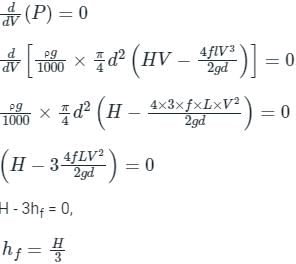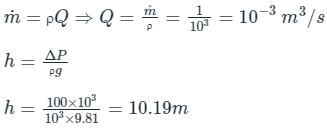Test: Power Transmission through Pipe - Civil Engineering (CE) MCQ
10 Questions MCQ Test Fluid Mechanics for Civil Engineering - Test: Power Transmission through Pipe
Maximum efficiency of power transmission through pipe is
The power available at the outlet of the pipe carrying water with a rate of flow of Q and an head of H supplied at the entrance of the pipe is
(γ is the specific weight: and hf is the loss of head due to friction)
(γ is the specific weight: and hf is the loss of head due to friction)
In a hydro project, a turbine is mounted in such a way that it acquires a head of 52 m. The water discharge in the feeding penstock with the flow rate of 4000 l/s. If the head loss of 6 m takes place in the penstock and the power of 900 kW is extracted from the turbine, The hydraulic efficiency of the turbine can be considered as 90 %. What should be the residual head loss of the turbine? (Take g = 10 m/s2)
Assertion: The hydraulic power transmitted by a pipe through a certain distance by means of water under pressure will be maximum when the loss of head due to friction over this distance is one-third of the total head supplied.
Reason: The average velocity of flow should be less than the critical velocity which corresponds to the laminar flow.
In case of power transmission through pipes, maximum efficiency is
The power transmitted through a pipe is maximum when the loss of head due to friction is given by (H = head supplied)
Water (density = 1000 kg/m3) at ambient temperature flows through a horizontal pipe of uniform cross section at the rate of 1 kg/s. If the pressure drop across the pipe is 100 kPa, the minimum power required to pump the water across the pipe, in watts, is ________
The condition for power transmission by flow through a pipeline to be maximum is that the loss of head of the flow due to friction throughout the pipeline length is:
When the flow is such that one third of the static head is consumed in pipe friction, the power delivered by the given pipeline will be:
On which of the factors does the co-efficent of bend in a pipe depend?
|
54 videos|96 docs|110 tests
|

































